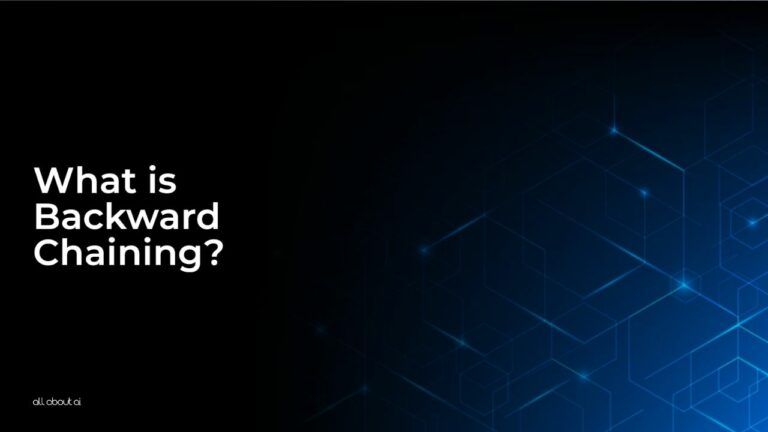Backward chaining is an inference method where an AI system starts with a goal or desired outcome and works backward through a series of rules and conditions to find the necessary steps or conditions to achieve that goal. It’s like solving a puzzle in reverse, beginning with the solution and tracing back to the initial conditions.
You can learn more about backward chaining by exploring this comprehensive article, expertly written by the AI virtuosos at All About AI.
Examples of Backward Chaining
Chatbots and Virtual Assistants: Chatbots and virtual assistants, like Siri and Alexa, use backward chaining when responding to user queries. They start with the user’s query or command and work backward through their knowledge base to find the most relevant response or action. For example, when asked, “What’s the weather today?” the system identifies the user’s goal (getting weather information). It then retrieves the current weather data for the user’s location.
Autonomous Vehicles: In self-driving cars, backward chaining is employed for decision-making. When faced with a complex traffic situation, the autonomous vehicle starts with the goal of safe navigation. It then works backward to assess various sensor inputs, traffic rules, and possible actions to determine the best course of action. These actions can include slowing down, changing lanes, or stopping.
Recommendation Systems: Online recommendation systems use backward chaining to suggest content or products to users. They begin with the user’s preferences and past interactions. They then work backward to identify items or content that align with the user’s interests. For instance, when recommending movies, the system starts with the user’s movie history and recommends films that match their viewing patterns and preferences.
Language Translation: Machine translation systems use backward chaining when translating text from one language to another. Starting with the source language sentence and the goal of producing an accurate translation, the system works backward by analyzing the source text’s grammar, vocabulary, and context to generate a coherent translation in the target language.
Use Cases of Backward Chaining
Natural Language Processing (NLP): In NLP applications, such as chatbots and virtual assistants, backward chaining is used for understanding and responding to user queries. The system starts with the user’s query and works backward through language models, semantic analysis, and intent recognition to formulate a relevant and contextually accurate response.
Computer Vision: In computer vision tasks, like object recognition and image segmentation, backward chaining helps identify objects within images or videos. The AI system begins with the goal of recognizing specific objects and works backward through neural networks and feature extraction to detect and classify objects accurately.
Content Generation: AI-driven content generation, including text and image creation, uses backward chaining to ensure content relevance. Starting with a desired content theme or objective, the system works backward to generate text, images, or multimedia content that aligns with the intended purpose.
Personalized Recommendations: Recommendation systems in e-commerce and content streaming platforms utilize backward chaining to suggest products or content to users. The AI system starts with user preferences, browsing history, and behavior and works backward to identify items or content that match the user’s interests, increasing user engagement and satisfaction.
Virtual Simulation: In virtual environments and simulations, backward chaining helps AI-driven entities make decisions. For instance, in flight simulators, AI pilots start with the goal of completing a safe flight and work backward through flight dynamics and control inputs to simulate realistic aircraft behavior and pilot responses.
Pros and Cons
Pros
- Backward chaining is goal-driven, making it well-suited for tasks where the desired outcome is known.
- It can be efficient when searching for a specific solution or path to a goal.
- The reasoning process is often transparent, making it easier to understand and debug.
Cons
- Backward chaining may miss alternative solutions or overlook certain possibilities.
- In some cases, it can lead to complex logical reasoning and large search spaces.
- Backward chaining is most effective when the goal is clear. However, it may not be suitable for tasks with ambiguous objectives.
FAQs
What is backward chaining in artificial intelligence?
Backward chaining in AI is a reasoning method where the system starts with a desired goal and works backward through a series of rules and conditions to determine the steps or conditions required to achieve that goal.
What will be returned by backward chaining AI algorithm?
A backward chaining AI algorithm typically returns a set of conditions, actions, or steps that need to be satisfied or executed to reach the specified goal or desired outcome.
What is the difference between forward and backward chaining in AI?
Forward chaining starts with available information and progresses toward a conclusion. Backward chaining begins with a desired goal and works backward to find the necessary conditions or steps to achieve that goal.
Why is backward chaining used for diagnostic problems?
Backward chaining is favored for diagnostic problems because it allows the system to start with observed symptoms or issues. It then traces back to identify the underlying causes or conditions. This is crucial in diagnosing and troubleshooting complex issues efficiently.
Key Takeaways
- Backward chaining is a reasoning method in AI that starts with a goal and works backward through rules and conditions to achieve that goal.
- It finds applications in medical diagnosis, troubleshooting, legal reasoning, planning, and game playing.
- Pros include goal-oriented reasoning, efficiency, and transparency, while cons include limited exploration and complexity.
Conclusion
Backward chaining plays a pivotal role in problem-solving and decision-making when it comes to artificial intelligence. This goal-oriented reasoning method empowers AI systems to work backward from desired outcomes. This provides valuable insights and solutions across various domains.
To explore more AI-related terms and concepts, keep reading through our AI Lexicon, a treasure trove of AI-related information.





